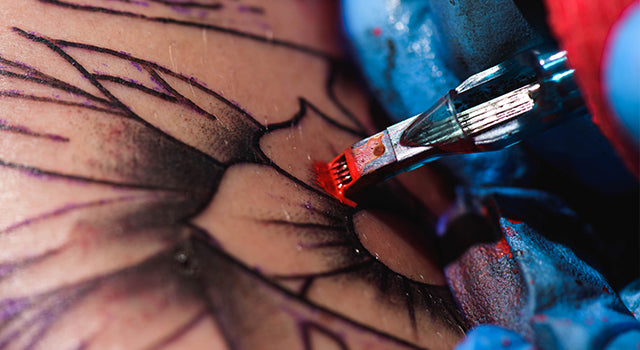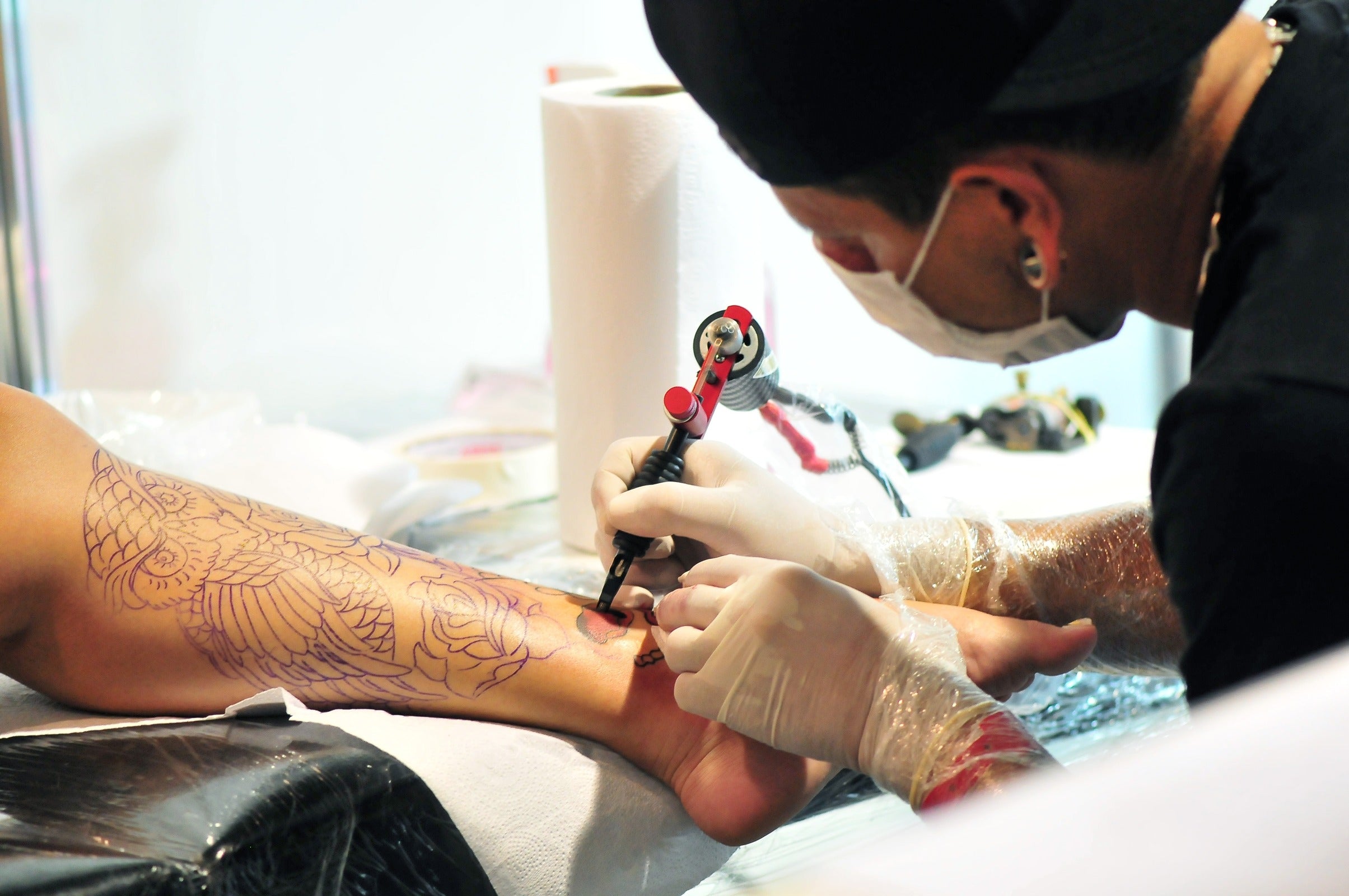Taking blood thinners before a tattoo can increase the blood-thinning effect, making blood flow easier through needle-created holes. Introducing ink, metal, or foreign materials during tattooing may affect your immune system, raising the risk of exposure to harmful viruses, especially in unregulated or unsafe environments.
Getting tattoos while on blood thinners is not ideal because of the risk of severe bruising and infection. If your doctor approves pausing the blood thinner after 3-6 months of treatment, you can get a tattoo.
This blog post explores the colorful yet cautious road of getting tattooed on blood thinners. Delve into the risks and precautions, and potentially find alternative means to express individuality without needles.
Key Takeaways
- Blood thinners increase bleeding, affecting tattoo healing and appearance.
- Prolonged bleeding risks infection and may require extended healing.
- Ink loss and bruising are more likely, and touch-ups may be needed.
- Consult a doctor before tattooing and prepare for aftercare.
- Consider temporary tattoos as a safe alternative.
Can You Get Tattoos On Blood Thinners: 4 Health Risks
Getting a tattoo involves more than choosing a design and a spot on your body. Especially if you're on blood thinners, it's crucial to understand the health risks involved. We will discuss the major concerns when mixing tattoos with blood-thinning medication: prolonged bleeding, infection, tattoo healing, and an overview of excessive bruising.
Prolonged Bleeding: What You Need to Know

- Blood Thinner Basics: These medications prevent blood clots, leading to easier bleeding.
- During the Tattoo Process: The needle's puncture can cause more bleeding than usual. This isn't just about the ink; it's a safety concern.
- Why It's a Problem: More bleeding can make the tattooing process harder to complete and may affect the last appearance of your tattoo.

Infection Risks: A Closer Look
- Open Wound Concerns: Tattoos are open wounds. On blood thinners, prolonged bleeding can turn a normal healing process into an extended one.
- The Infection Connection: Longer healing times increase the risk of bacteria-causing infections. Infections are not just about discomfort; they can lead to serious health issues.
Excessive Bruising: A Visual and Physical Concern
- Bruising Basics: Bruises are common after getting a tattoo, but blood thinners can amplify this effect.
- What to Expect: You might notice more significant, colorful bruises around your tattoo. While usually harmless, they can be uncomfortable and affect your tattoo's appearance during healing.
- Management Tips: Ice packs and elevation can help manage bruising, but patience is key as your body heals.
Impact on Healing and Ink Loss

- Healing Takes Time: Your body's healing process slows down on blood thinners. This means the tattoo takes longer to "settle."
- Ink Loss Explained: Excessive bleeding can lead to less ink on the skin. This might mean your tattoo looks faded or uneven once healed.
- Touch-Ups May Be Needed: Be prepared for additional sessions to correct ink loss, which could mean more time and expense.
Tattooing on Blood Thinners: 4 Precautions
If you're taking blood thinners and thinking about getting a tattoo, moving forward carefully is essential. Here, we share some key advice and precautions to help ensure your tattooing experience is good.
Consulting Your Healthcare Provider: The First Step
- Why It Matters: Your doctor knows your medical history and how blood thinners affect you. They can give you personalized advice.
- Questions to Ask: Ask the tattoo artist if getting a tattoo is safe for you and if there are any extra precautions you should take.
Preparing for Your Tattoo
- Before the Appointment: Follow your doctor's advice about managing your medication.
- Day of the Tattoo: Eat a good meal and stay hydrated. This can help you feel your best during the tattoo session.
Understanding the Need for Touch-Ups
- Be Prepared for Changes: Tattoos on blood thinners might not heal as expected, leading to faded areas or uneven lines.
- Budget for Touch-Ups: Knowing you need additional sessions can help you plan financially, as touch-ups will add to the overall cost.

Importance of Post-Tattoo Care
- Follow Through with Aftercare: Proper aftercare is crucial for everyone, even more so if you're on blood thinners. It can help prevent infection and ensure your tattoo heals well.
- Keep an Eye on Healing: Closely monitor your tattoo’s healing process. If something doesn't look right, consult your healthcare provider.
Blood Thinners and Expression: 4 Alternatives and 5 Strategies
Deciding to get a tattoo while on Blood Thinners requires careful consideration. Several creative and fun options exist for those who decide against it or seek safer ways to express themselves. And for those who still lean towards getting inked, we have some guidelines to ensure your safety and satisfaction.
Alternatives to Traditional Tattoos: Safe Expressions

When on blood thinners, getting a traditional tattoo might have extra risks. But don't worry! Many creative and safe ways exist to express your unique style without permanent ink. Let's dive into some cool alternatives that let you showcase your personality with no needles required.
Temporary Tattoos: Fun Without the Commitment
- Just Like the Real Deal: Modern temporary tattoos look incredibly real and can last a few days to weeks.
- Endless Designs: Whether you love intricate patterns, bold statements, or colorful artwork, there's a temporary tattoo for every taste.

Henna Art: A Traditional Touch
- Natural and Safe: Henna is a plant-based dye used for centuries to create beautiful, temporary body art.
- Cultural Richness: Dive into the rich history and cultural significance behind henna designs.
- Customizable: Work with a henna artist to create a design that’s uniquely yours.
Body Paint: Unleash Your Inner Artist
- Vibrant and Versatile: Body paint allows full creativity with colors and designs tailored to your mood or event.
- Temporary Canvas: Enjoy your masterpiece for a day, wash it off, and plan your next creation.
- Safe for the Skin: Choose body paints that are non-toxic and skin-friendly to avoid irritation.
Stick-On Jewelry and Crystal Tattoos
- Shine and Sparkle: Add some bling to your skin with stick-on jewelry or crystal tattoos that catch the light beautifully.
- No Piercing Required: Get the look of piercings with no needles. This option is perfect for those who want to experiment with their style.
- Mix and Match: Combine original pieces to create a look that’s all your own.
Blood Thinner Tattoo Recommendations

After thoughtful consideration of the potential risks linked to getting a tattoo, if you're determined to move forward, there are steps you can follow for a safer experience. Adhering to these guidelines can reduce complications and help you achieve your desired outcome confidently.
- Consult Your Doctor: Before anything else, talk to your doctor. They might adjust your medication temporarily or give specific advice.
- Choose an Experienced Tattoo Artist: Find an artist familiar with tattooing individuals on blood thinners. They'll know how to handle any extra bleeding.
- Be Open About Your Situation: Always inform your tattoo artist about your condition. Transparency helps them take the precautions.
- Plan for Extra Aftercare: Healing might take longer, so follow aftercare instructions meticulously and be prepared for a longer healing process.
- Consider the Tattoo's Placement: Some areas of the body bleed less and might be better suited for your situation.

Conclusion
Ultimately, the art of self-expression through tattoos is a dance between individuality and safety. Before delving into the tattoo world, assessing the specific risks for individuals on blood thinners is vital.
Opt for a vibrant tattoo only if you're in good health, with your well-being as the top priority. Dive into ink with thoughtfulness and consult your healthcare provider for guidance, weighing all risks and exploring diverse ways to express yourself.
Your health should always be the focus, as there's nothing more exquisite than a life lived vibrantly, whether adorned with tattoos.

![Tattoos on Blood Thinners: 4 Risks 4 Precautions [with 4 Alternatives]](http://drnumb.com/cdn/shop/articles/Can_You_Get_Tattoos_On_Blood_Thinners__4_Risks_4_Precautions_4_Alternatives.jpg?v=1714125636&width=1100)





![Antibiotics and Tattoos: 3 Risks and 3 Effects [with 4 Precautions]](http://drnumb.com/cdn/shop/articles/Can_You_Get_Tattooed_On_Antibiotics__3_Risks_and_3_Effects_4_Precautions.jpg?v=1714128292)




